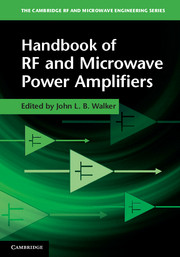Book contents
- Frontmatter
- Contents
- Contributors
- Preface
- 1 Silicon LDMOS and VDMOS transistors
- 2 GaAs FETs – physics, design, and models
- 3 Wide band gap transistors – SiC and GaN – physics, design and models
- 4 Amplifier classes, A to S
- 5 Computer-aided design of power amplifiers
- 6 Practical HF/VHF/UHF RF power amplifier realization
- 7 Microwave hybrid amplifier realization
- 8 Monolithic power amplifiers
- 9 RF power amplifier thermal design
- 10 Reliability
- 11 Power amplifier applications
- 12 Amplifier measurements
- About the authors
- Index
- References
6 - Practical HF/VHF/UHF RF power amplifier realization
Published online by Cambridge University Press: 05 November 2011
- Frontmatter
- Contents
- Contributors
- Preface
- 1 Silicon LDMOS and VDMOS transistors
- 2 GaAs FETs – physics, design, and models
- 3 Wide band gap transistors – SiC and GaN – physics, design and models
- 4 Amplifier classes, A to S
- 5 Computer-aided design of power amplifiers
- 6 Practical HF/VHF/UHF RF power amplifier realization
- 7 Microwave hybrid amplifier realization
- 8 Monolithic power amplifiers
- 9 RF power amplifier thermal design
- 10 Reliability
- 11 Power amplifier applications
- 12 Amplifier measurements
- About the authors
- Index
- References
Summary
Introduction
This discussion focuses on the practical realization of radio frequency power amplifiers (RFPAs), the process that exists between nothing and something, the path an RFPA design engineer can take from the RFPA application conceptual phase to the construction of actual hardware.
Since the end use application/market defines and drives the need for an RFPA, an overview of major application areas is covered initially. The applications will demand that certain RFPA specifications are satisfied, so an overview of generic amplifier specifications relative to several applications is logically provided next. The specifications are viewed from several vantage points, i.e., they are covered qualitatively, in other words, for a particular application, which RFPA specifications are most relevant. Then they are defined quantitatively, not so much for a unique application, but with a bias towards the RFPA itself, with an effort to provide a guideline as to what constitutes a realistic specification value, and what does not.
- Type
- Chapter
- Information
- Handbook of RF and Microwave Power Amplifiers , pp. 232 - 283Publisher: Cambridge University PressPrint publication year: 2011
References
- 2
- Cited by

